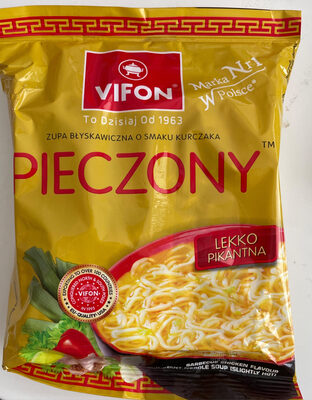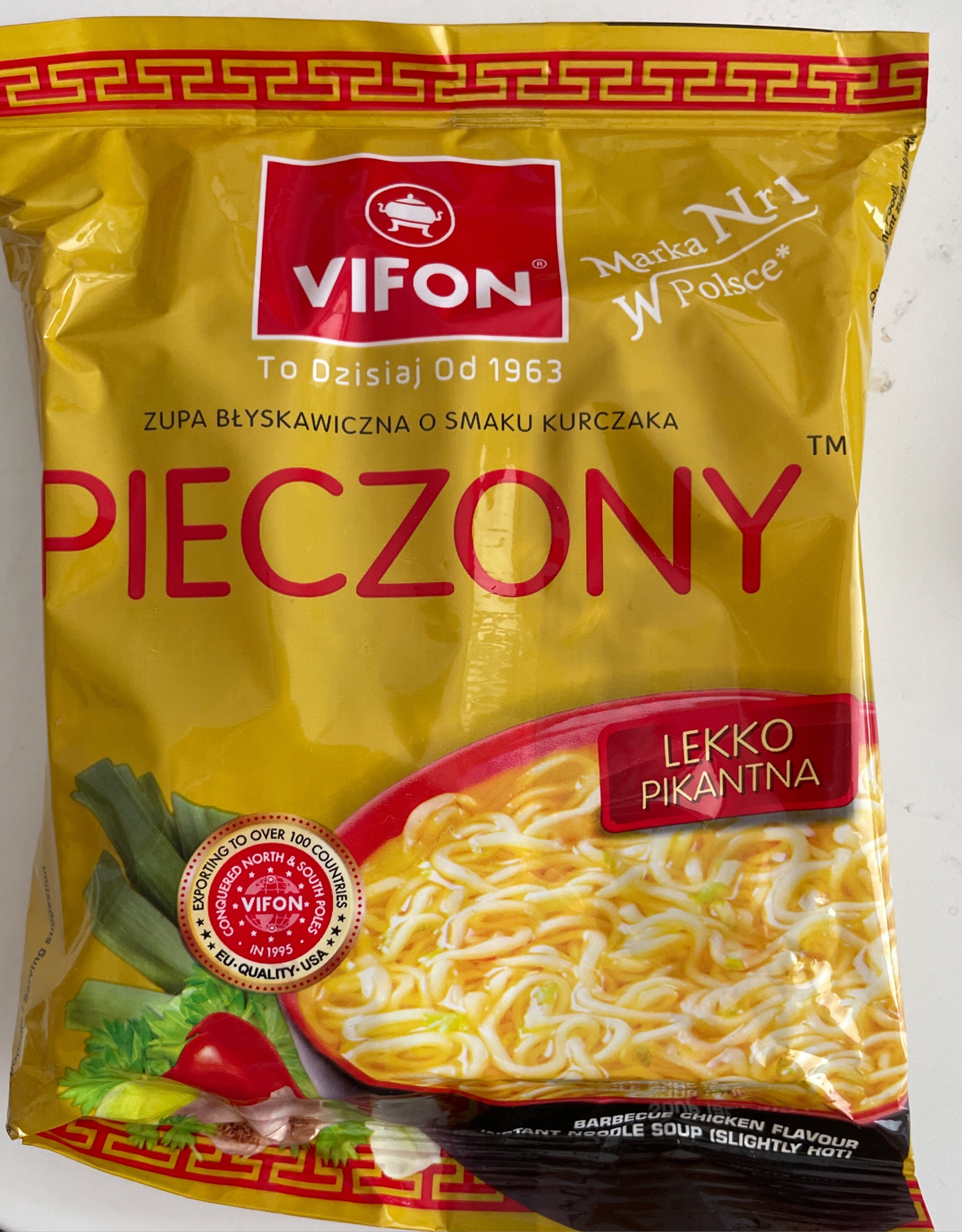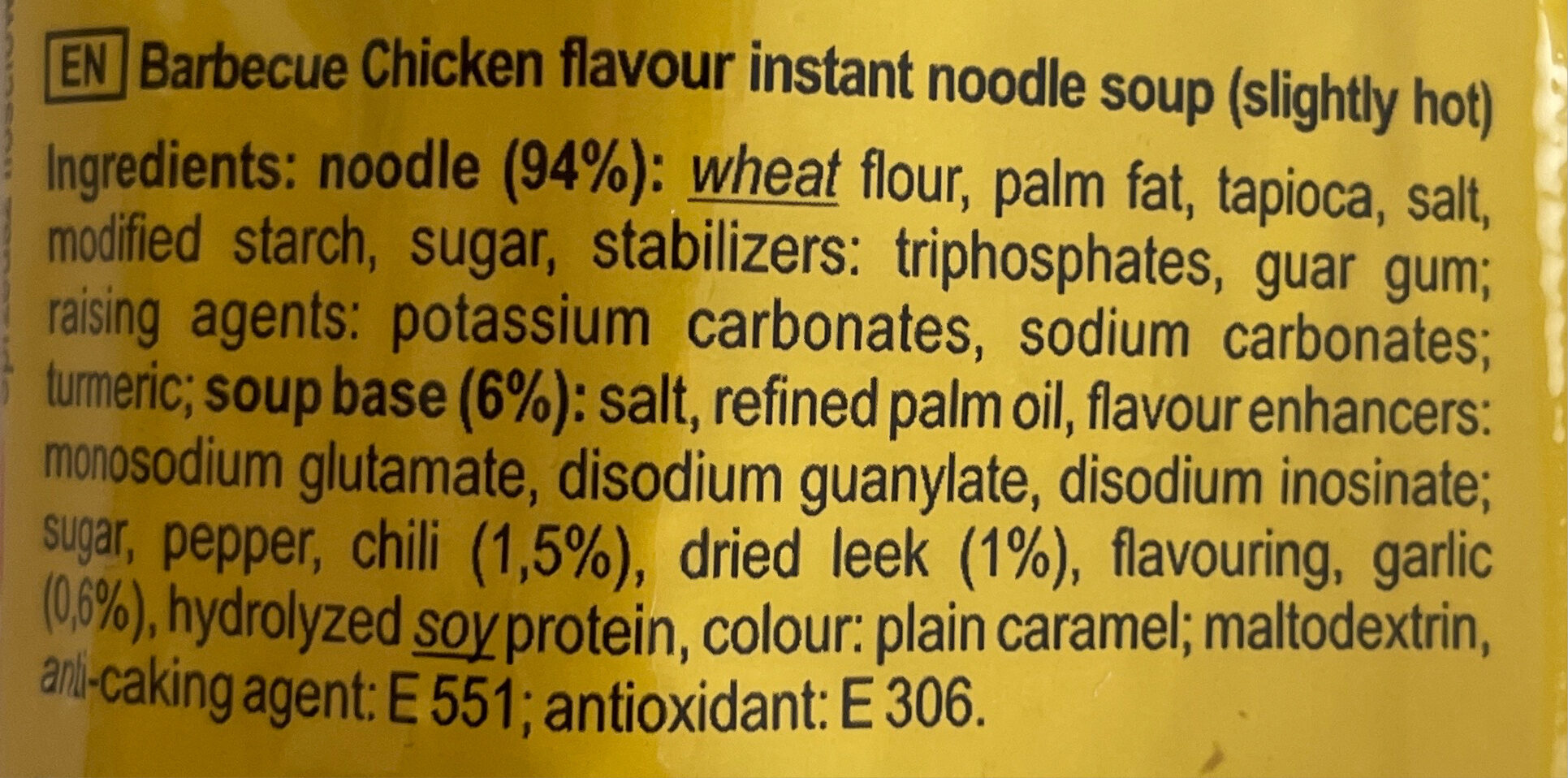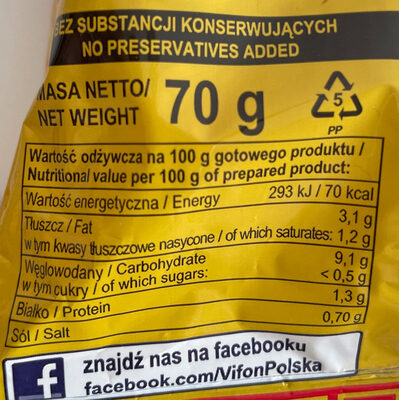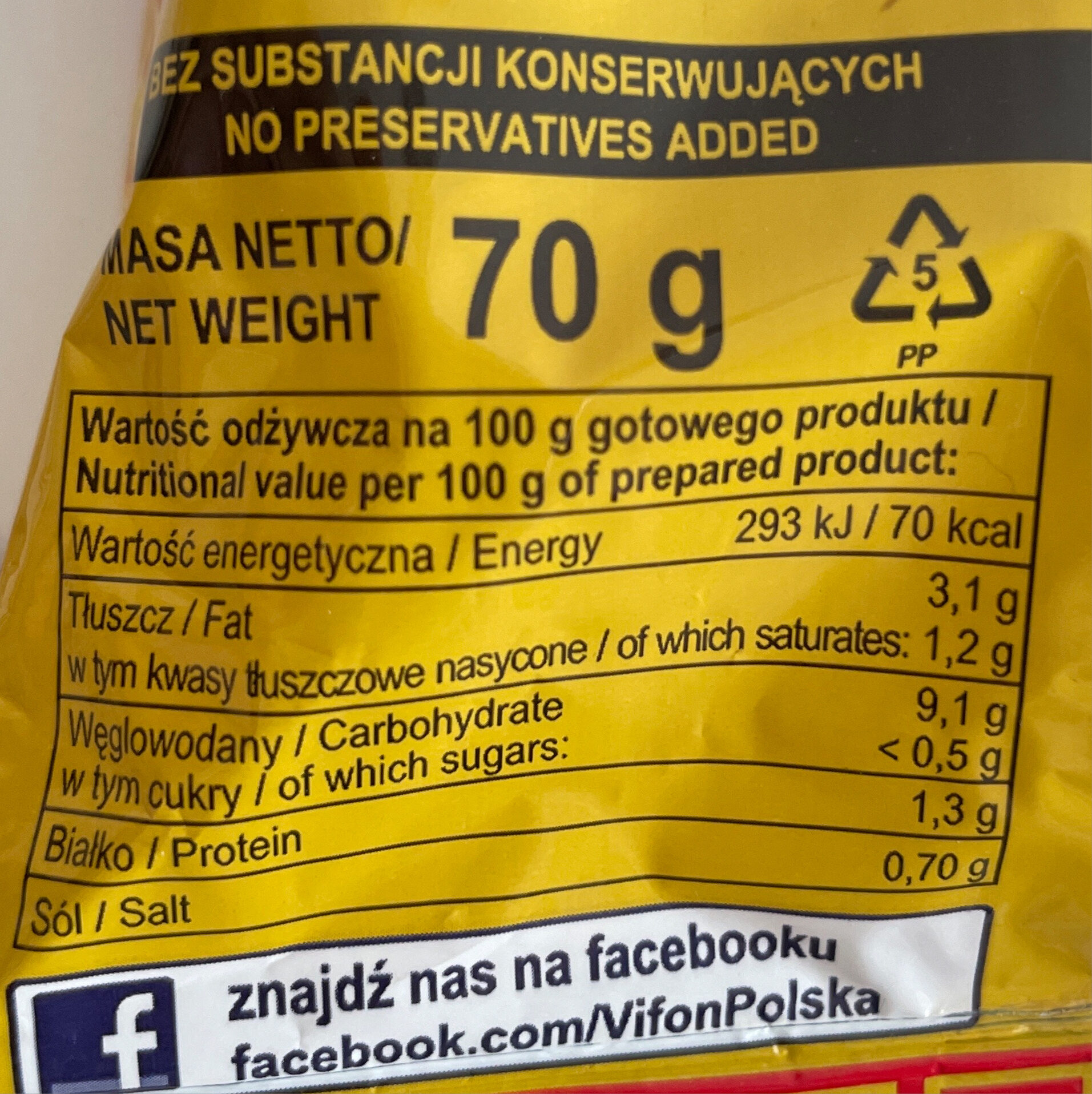Help us make food transparency the norm!
As a non-profit organization, we depend on your donations to continue informing consumers around the world about what they eat.
The food revolution starts with you!
Pieczony - Vifon - 70 g
Pieczony - Vifon - 70 g
This product page is not complete. You can help to complete it by editing it and adding more data from the photos we have, or by taking more photos using the app for Android or iPhone/iPad. Thank you!
×
Barcode: 5901882110090 (EAN / EAN-13)
Common name: Zupka błyskawiczna o smaku kurczaka lekko pikantna
Quantity: 70 g
Packaging: Plastic
Categories: Plant-based foods and beverages, Plant-based foods, Meals, Dried products, Pastas, Dried products to be rehydrated, Noodles, Instant noodles, Instant noodle soups
Labels, certifications, awards: No preservatives, pl:Laur Konsumenta
Manufacturing or processing places: Wietnam
Stores: Auchan, E.Lecelrc, Stokrotka
Countries where sold: Poland
Matching with your preferences
Health
Ingredients
-
35 ingredients
: makaron (94%)[mąka pszenna, tłuszcz palmowy, tapioka, sól, skrobia modyfikowana, cukier, stabilizatory (trifosforany, guma guar); substancje spulchniające (węglany potasu, węglany sodu); kurkuma]; przyprawa (6%): sól, rafinowany olej palmowy, cukier, wzmacniacze smaku (glutaminian monosodowy, guanylan disodowy, inozynian disodowy); maltodekstryna, pieprz, czosnek (1,5%), chili (1,5%), suszony por (1%), aromat, hydrolizat białka sojowego, barwnik: karmel; substancja przeciwzbrylająca: E 551; przeciwutleniacz: E 306.Allergens: Gluten, Soybeans, pl:gliten, pl:sojowego, pl:sojowego
Food processing
-
Ultra processed foods
Elements that indicate the product is in the 4 - Ultra processed food and drink products group:
- Additive: E14XX - Modified Starch
- Additive: E150 - Caramel
- Additive: E412 - Guar gum
- Additive: E451 - Triphosphates
- Additive: E551 - Silicon dioxide
- Additive: E621 - Monosodium glutamate
- Additive: E627 - Disodium guanylate
- Additive: E631 - Disodium inosinate
- Ingredient: Colour
- Ingredient: Flavour enhancer
- Ingredient: Flavouring
- Ingredient: Maltodextrin
Food products are classified into 4 groups according to their degree of processing:
- Unprocessed or minimally processed foods
- Processed culinary ingredients
- Processed foods
- Ultra processed foods
The determination of the group is based on the category of the product and on the ingredients it contains.
Additives
-
E412 - Guar gum
Guar gum (E412) is a natural food additive derived from guar beans.
This white, odorless powder is valued for its remarkable thickening and stabilizing properties, making it a common ingredient in various food products, including sauces, dressings, and ice creams.
When used in moderation, guar gum is considered safe for consumption, with no known adverse health effects.
-
E451 - Triphosphates
Sodium triphosphate: Sodium triphosphate -STP-, also sodium tripolyphosphate -STPP-, or tripolyphosphate -TPP-,- is an inorganic compound with formula Na5P3O10. It is the sodium salt of the polyphosphate penta-anion, which is the conjugate base of triphosphoric acid. It is produced on a large scale as a component of many domestic and industrial products, especially detergents. Environmental problems associated with eutrophication are attributed to its widespread use.Source: Wikipedia
-
E500 - Sodium carbonates
Sodium carbonates (E500) are compounds commonly used in food preparation as leavening agents, helping baked goods rise by releasing carbon dioxide when they interact with acids.
Often found in baking soda, they regulate the pH of food, preventing it from becoming too acidic or too alkaline. In the culinary world, sodium carbonates can also enhance the texture and structure of foods, such as noodles, by modifying the gluten network.
Generally recognized as safe, sodium carbonates are non-toxic when consumed in typical amounts found in food.
-
E551 - Silicon dioxide
Silicon dioxide: Silicon dioxide, also known as silica, silicic acid or silicic acid anydride is an oxide of silicon with the chemical formula SiO2, most commonly found in nature as quartz and in various living organisms. In many parts of the world, silica is the major constituent of sand. Silica is one of the most complex and most abundant families of materials, existing as a compound of several minerals and as synthetic product. Notable examples include fused quartz, fumed silica, silica gel, and aerogels. It is used in structural materials, microelectronics -as an electrical insulator-, and as components in the food and pharmaceutical industries. Inhaling finely divided crystalline silica is toxic and can lead to severe inflammation of the lung tissue, silicosis, bronchitis, lung cancer, and systemic autoimmune diseases, such as lupus and rheumatoid arthritis. Uptake of amorphous silicon dioxide, in high doses, leads to non-permanent short-term inflammation, where all effects heal.Source: Wikipedia
-
E621 - Monosodium glutamate
Monosodium glutamate: Monosodium glutamate -MSG, also known as sodium glutamate- is the sodium salt of glutamic acid, one of the most abundant naturally occurring non-essential amino acids. Glutamic acid is found naturally in tomatoes, grapes, cheese, mushrooms and other foods.MSG is used in the food industry as a flavor enhancer with an umami taste that intensifies the meaty, savory flavor of food, as naturally occurring glutamate does in foods such as stews and meat soups. It was first prepared in 1908 by Japanese biochemist Kikunae Ikeda, who was trying to isolate and duplicate the savory taste of kombu, an edible seaweed used as a base for many Japanese soups. MSG as a flavor enhancer balances, blends, and rounds the perception of other tastes.The U.S. Food and Drug Administration has given MSG its generally recognized as safe -GRAS- designation. A popular belief is that large doses of MSG can cause headaches and other feelings of discomfort, known as "Chinese restaurant syndrome," but double-blind tests fail to find evidence of such a reaction. The European Union classifies it as a food additive permitted in certain foods and subject to quantitative limits. MSG has the HS code 29224220 and the E number E621.Source: Wikipedia
-
E627 - Disodium guanylate
Disodium guanylate: Disodium guanylate, also known as sodium 5'-guanylate and disodium 5'-guanylate, is a natural sodium salt of the flavor enhancing nucleotide guanosine monophosphate -GMP-. Disodium guanylate is a food additive with the E number E627. It is commonly used in conjunction with glutamic acid. As it is a fairly expensive additive, it is not used independently of glutamic acid; if disodium guanylate is present in a list of ingredients but MSG does not appear to be, it is likely that glutamic acid is provided as part of another ingredient such as a processed soy protein complex. It is often added to foods in conjunction with disodium inosinate; the combination is known as disodium 5'-ribonucleotides. Disodium guanylate is produced from dried seaweed and is often added to instant noodles, potato chips and other snacks, savory rice, tinned vegetables, cured meats, and packaged soup.Source: Wikipedia
-
E631 - Disodium inosinate
Disodium inosinate: Disodium inosinate -E631- is the disodium salt of inosinic acid with the chemical formula C10H11N4Na2O8P. It is used as a food additive and often found in instant noodles, potato chips, and a variety of other snacks. Although it can be obtained from bacterial fermentation of sugars, it is often commercially prepared from animal sources.Source: Wikipedia
Ingredients analysis
-
Palm oil
Ingredients that contain palm oil: Palm fat, Refined palm oil
-
Maybe vegan
Ingredients that may not be vegan: E627, E631, Flavouring
-
Maybe vegetarian
Ingredients that may not be vegetarian: E627, E631, Flavouring
-
Details of the analysis of the ingredients
: makaron 94% (mąka _pszenna_, tłuszcz palmowy, tapioka, sól, skrobia modyfikowana, cukier, stabilizatory (trifosforany, guma guar), substancje spulchniające (węglany potasu, węglany sodu), kurkuma), przyprawa 6% (sól), rafinowany olej palmowy, cukier, wzmacniacze smaku (glutaminian monosodowy, guanylan disodowy, inozynian disodowy), maltodekstryna, pieprz, czosnek 1.5%, chili 1.5%, por 1%, aromat, hydrolizat białka _sojowego_, barwnik (karmel), substancja przeciwzbrylająca (e551), przeciwutleniacz (e306)- makaron -> en:pasta - vegan: maybe - vegetarian: maybe - ciqual_proxy_food_code: 9810 - percent: 94
- mąka _pszenna_ -> en:wheat-flour - vegan: yes - vegetarian: yes - ciqual_proxy_food_code: 9410
- tłuszcz palmowy -> en:palm-fat - vegan: yes - vegetarian: yes - from_palm_oil: yes - ciqual_proxy_food_code: 16129
- tapioka -> en:tapioca - vegan: yes - vegetarian: yes - ciqual_proxy_food_code: 9510
- sól -> en:salt - vegan: yes - vegetarian: yes - ciqual_food_code: 11058
- skrobia modyfikowana -> en:modified-starch - vegan: yes - vegetarian: yes - ciqual_proxy_food_code: 9510
- cukier -> en:sugar - vegan: yes - vegetarian: yes - ciqual_proxy_food_code: 31016
- stabilizatory -> en:stabiliser
- trifosforany -> en:e451 - vegan: yes - vegetarian: yes
- guma guar -> en:e412 - vegan: yes - vegetarian: yes
- substancje spulchniające -> en:raising-agent
- węglany potasu -> en:e501 - vegan: yes - vegetarian: yes
- węglany sodu -> en:e500 - vegan: yes - vegetarian: yes
- kurkuma -> en:turmeric - vegan: yes - vegetarian: yes - ciqual_proxy_food_code: 11089
- przyprawa -> en:condiment - vegan: maybe - vegetarian: maybe - percent: 6
- sól -> en:salt - vegan: yes - vegetarian: yes - ciqual_food_code: 11058
- rafinowany olej palmowy -> en:refined-palm-oil - vegan: yes - vegetarian: yes - from_palm_oil: yes - ciqual_food_code: 16150
- cukier -> en:sugar - vegan: yes - vegetarian: yes - ciqual_proxy_food_code: 31016
- wzmacniacze smaku -> en:flavour-enhancer
- glutaminian monosodowy -> en:e621 - vegan: yes - vegetarian: yes
- guanylan disodowy -> en:e627 - vegan: maybe - vegetarian: maybe
- inozynian disodowy -> en:e631 - vegan: maybe - vegetarian: maybe
- maltodekstryna -> en:maltodextrin - vegan: yes - vegetarian: yes
- pieprz -> en:pepper - vegan: yes - vegetarian: yes
- czosnek -> en:garlic - vegan: yes - vegetarian: yes - ciqual_food_code: 11000 - percent: 1.5
- chili -> en:chili-pepper - vegan: yes - vegetarian: yes - ciqual_food_code: 20151 - percent: 1.5
- por -> en:leek - vegan: yes - vegetarian: yes - ciqual_food_code: 20039 - percent: 1
- aromat -> en:flavouring - vegan: maybe - vegetarian: maybe
- hydrolizat białka _sojowego_ -> en:hydrolysed-soy-protein - vegan: yes - vegetarian: yes - ciqual_food_code: 20591
- barwnik -> en:colour
- karmel -> en:e150 - vegan: yes - vegetarian: yes
- substancja przeciwzbrylająca -> en:anti-caking-agent
- e551 -> en:e551 - vegan: yes - vegetarian: yes
- przeciwutleniacz -> en:antioxidant
- e306 -> en:e306 - vegan: yes - vegetarian: yes
- makaron -> en:pasta - vegan: maybe - vegetarian: maybe - ciqual_proxy_food_code: 9810 - percent: 94
Nutrition
-
Average nutritional quality
⚠ ️Warning: the amount of fruits, vegetables and nuts is not specified, their possible positive contribution to the grade could not be taken into account.This product is not considered a beverage for the calculation of the Nutri-Score.
Positive points: 0
- Proteins: 0 / 5 (value: 1.3, rounded value: 1.3)
- Fiber: 0 / 5 (value: 0, rounded value: 0)
- Fruits, vegetables, nuts, and colza/walnut/olive oils: 0 / 5 (value: 0, rounded value: 0)
Negative points: 4
- Energy: 0 / 10 (value: 293, rounded value: 293)
- Sugars: 0 / 10 (value: 0.5, rounded value: 0.5)
- Saturated fat: 1 / 10 (value: 1.2, rounded value: 1.2)
- Sodium: 3 / 10 (value: 280, rounded value: 280)
The points for proteins are counted because the negative points are less than 11.
Nutritional score: (4 - 0)
Nutri-Score:
-
Nutrient levels
-
Fat in moderate quantity (3.1%)
What you need to know- A high consumption of fat, especially saturated fats, can raise cholesterol, which increases the risk of heart diseases.
Recommendation: Limit the consumption of fat and saturated fat- Choose products with lower fat and saturated fat content.
-
Saturated fat in low quantity (1.2%)
What you need to know- A high consumption of fat, especially saturated fats, can raise cholesterol, which increases the risk of heart diseases.
Recommendation: Limit the consumption of fat and saturated fat- Choose products with lower fat and saturated fat content.
-
Sugars in low quantity (0.5%)
What you need to know- A high consumption of sugar can cause weight gain and tooth decay. It also augments the risk of type 2 diabetes and cardio-vascular diseases.
Recommendation: Limit the consumption of sugar and sugary drinks- Sugary drinks (such as sodas, fruit beverages, and fruit juices and nectars) should be limited as much as possible (no more than 1 glass a day).
- Choose products with lower sugar content and reduce the consumption of products with added sugars.
-
Salt in moderate quantity (0.7%)
What you need to know- A high consumption of salt (or sodium) can cause raised blood pressure, which can increase the risk of heart disease and stroke.
- Many people who have high blood pressure do not know it, as there are often no symptoms.
- Most people consume too much salt (on average 9 to 12 grams per day), around twice the recommended maximum level of intake.
Recommendation: Limit the consumption of salt and salted food- Reduce the quantity of salt used when cooking, and don't salt again at the table.
- Limit the consumption of salty snacks and choose products with lower salt content.
-
-
Nutrition facts
Nutrition facts Prepared
for 100 g / 100 mlCompared to: Instant noodle soups Energy 293 kj
(70 kcal)Fat 3.1 g Saturated fat 1.2 g Carbohydrates 9.1 g Sugars < 0.5 g Fiber - Proteins 1.3 g Salt 0.7 g Fruits‚ vegetables‚ nuts and rapeseed‚ walnut and olive oils (estimate from ingredients list analysis) ?
Environment
-
Eco-Score D - High environmental impact
⚠ ️Select a country in order to include the full impact of transportation.The Eco-Score is an experimental score that summarizes the environmental impacts of food products.→ The Eco-Score was initially developped for France and it is being extended to other European countries. The Eco-Score formula is subject to change as it is regularly improved to make it more precise and better suited to each country.Life cycle analysis
-
Average impact of products of the same category: B (Score: 66/100)
Category: Soup, Asian-style with noodles, prepacked, to be reheated
Category: Soup, Asian-style with noodles, prepacked, to be reheated
- PEF environmental score: 0.38 (the lower the score, the lower the impact)
- including impact on climate change: 3.15 kg CO2 eq/kg of product
Stage Impact Agriculture
59.3 %Processing
25.0 %Packaging
2.6 %Transportation
10.7 %Distribution
1.2 %Consumption
1.1 %
Bonuses and maluses
-
Missing origins of ingredients information
Malus: -5
⚠ ️ The origins of the ingredients of this product are not indicated.
If they are indicated on the packaging, you can modify the product sheet and add them.
If you are the manufacturer of this product, you can send us the information with our free platform for producers.
-
Ingredients that threatens species
Malus: -10
Contains palm oil
Tropical forests in Asia, Africa and Latin America are destroyed to create and expand oil palm tree plantations. The deforestation contributes to climate change, and it endangers species such as the orangutan, the pigmy elephant and the Sumatran rhino.
-
Packaging with a high impact
Malus: -15
Shape Material Recycling Impact 1 Bag Plastic High 1 Packet Plastic High 2 Packet Plastic Discard High
Eco-Score for this product
-
Impact for this product: D (Score: 36/100)
Product: Pieczony - Vifon - 70 g
Life cycle analysis score: 66
Sum of bonuses and maluses: -30
Final score: 36/100
-
Carbon footprint
-
Equal to driving 1.6 km in a petrol car
315 g CO² per 100g of product
The carbon emission figure comes from ADEME's Agribalyse database, for the category: Soup, Asian-style with noodles, prepacked, to be reheated (Source: ADEME Agribalyse Database)
Stage Impact Agriculture
62.1 %Processing
19.1 %Packaging
3.2 %Transportation
14.7 %Distribution
0.5 %Consumption
0.4 %
Packaging
-
Packaging with a high impact
-
Packaging parts
2 x Packet (Plastic)
1 x Bag (Plastic)
1 x Packet (Plastic)
-
Packaging materials
Material % Packaging weight Packaging weight per 100 g of product Plastic
-
Transportation
-
Origins of ingredients
Missing origins of ingredients information
⚠ ️ The origins of the ingredients of this product are not indicated.
If they are indicated on the packaging, you can modify the product sheet and add them.
If you are the manufacturer of this product, you can send us the information with our free platform for producers.Add the origins of ingredients for this product Add the origins of ingredients for this product
Threatened species
-
Contains palm oil
Drives deforestation and threatens species such as the orangutan
Tropical forests in Asia, Africa and Latin America are destroyed to create and expand oil palm tree plantations. The deforestation contributes to climate change, and it endangers species such as the orangutan, the pigmy elephant and the Sumatran rhino.
Report a problem
-
Incomplete or incorrect information?
Category, labels, ingredients, allergens, nutritional information, photos etc.
If the information does not match the information on the packaging, please complete or correct it. Open Food Facts is a collaborative database, and every contribution is useful for all.
Data sources
Product added on by karbonado
Last edit of product page on by arc2.
Product page also edited by charlesnepote, openfoodfacts-contributors, packbot, roboto-app, sierigh.
